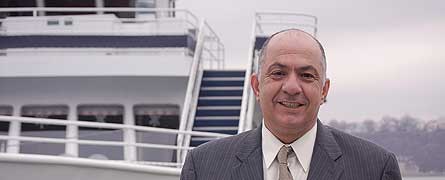A Greek Seaman in New York
by Katerina Georgiou
It’s a rainy November day, just after daybreak at Pier 81 and the Manhattan skyline is covered with fog. Cars dash by on the West Side Highway but the familiar strands of the city are otherwise absent. It’s not the drilling of the latest housing development I hear but the brisk wind that stirs the choppy waters of the Hudson. Crossing the gangplank, I enter the white barge that serves as the office of Gus Markou, 46, the man in charge of running New York’s most prominent fleet of passenger vessels—the Circle Line and World Yacht.
Photos adorn the corkboard at the entrance to the barge, including one from the 1980’s of Markou huddled with three co-workers. All are dressed in snappy, white uniforms smiling broadly and looking more like pals than co-workers. With most employees averaging 20 years with the company, the photos depict a camaraderie that’s hard to come by in today’s corporate world.

“I hope you don’t get seasick,” Markou says, looking up from a stack of paperwork, as I grip hold of a chair and glance at the shifting surroundings. Two icons of St. Nicholas, the patron saint of sailors, peer down at me from above the desk. Next to them hang blue architectural drawings of the new ships that Circle Line intends to launch over the next two years.
Under Markou’s supervision a team of 120 people, including captains, engineers and deck hands operate this stalwart enterprise that caters to more than 1.5 million people annually.
Markou has come a long way since he first stepped foot on a boat as a 12 year old refugee fleeing Cyprus in 1974. (With the island’s only airport under Turkish occupation, there was no choice but to leave by boat.) Up until then, Markou had never given any thought to leaving his homeland.
“I thought I’d stay there forever,” he says with a wistful grin. “After the invasion, I thought I’d go back.”
Today, Markou still marvels at the direction his life has taken and most of all, his improbable career as a seaman in New York.
“In Cyprus, my father was a farmer so I didn’t see the water a lot,” he says. “We used to go to the beach in Kyrenia during the summer. Back then, it was a big deal to go the beach.”
Instead, he discovered his fondness for the water as a teenager in an unlikely place: along New York’s West Side Highway. While exploring the pier off Christopher Street he stumbled upon the startling sight of a 700 ft steamboat moored in the Hudson. Mesmerized by the size and bearing of the ship, he stood there for hours wondering to himself: “How does this thing stay afloat?”
He soon discovered it was no ordinary ship. The SS John W. Brown was a WWII Liberty vessel used during the invasion of southern France. After the war, it became a floating vocational high school for young men seeking seafaring careers. Students dressed in naval uniforms and learned how to navigate the old-fashioned way—using the stars. His skill and passion garnered the attention of the school’s principal, a former oil tanker captain. He encouraged Markou to spend summer vacations working with Columbia University aboard a ship that traveled between Albany and the LI Sound studying the tide and testing the water for pollutants.

“I think people are born with some kind of talent,” Markou says. “Maybe it was a combination of being young and curious but it just came easily to me. I was born to do this.”
He flashes a playful smile before continuing, “Besides, I would’ve been a lousy farmer. I have trouble planting tomatoes in my backyard.”
Markou began his career as a port engineer at World Yacht and rose the ranks to his current position as Director of Maritime Operations in 1994. Today, he handles the day-to-day operations for the more than 25 ships that make up the Circle Line and World Yacht—such as ensuring passenger safety and complying with Coast Guard requirements. His biggest project to date is overseeing a $26 million expansion that will replace some of the older Circle Line vessels with modern, state-of-the-art ones.

In a job where no two days are alike, being calm under pressure is perhaps Markou’s greatest asset. He was put to the test on 9/11 when he witnessed the second plane hit the World Trade Center. He sprang into action and together with the Coast Guard coordinated the evacuation of more than 100,000 people fleeing the city.
“Working on the water teaches you to take a situation, assess it and try to deal with it in the best way possible,” he says. “You must depend on your crew because, just like in life, you can’t do everything by yourself.”
But he’s quick to add that his job isn’t for anyone.
“A lot of people don’t want the responsibility,” he says. “You’ve got to take it seriously. You have to follow the rules and regulations but you can’t be afraid. You have to use your instinct.”
Therein lies the key to Markou’s success. Guided by an internal map, he discovered the point where passion intersects with instinct and has chartered his own journey ever since.